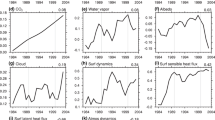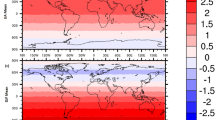Abstract
A quantitative attribution analysis is performed on the systematic atmospheric temperature biases in a coupled climate system model (flexible global ocean–atmosphere–land system model, spectral version 2) in reference to the European Center for Medium-Range Weather Forecasts, Re-analysis Interim data during 1979–2005. By adopting the coupled surface–atmosphere climate feedback response analysis method, the model temperature biases are related to model biases in representing the radiative processes including water vapor, ozone, clouds and surface albedo, and the non-radiative processes including surface heat fluxes and other dynamic processes. The results show that the temperature biases due to biases in radiative and non-radiative processes tend to compensate one another. In general, the radiative biases tend to dominate in the summer hemisphere, whereas the non-radiative biases dominate in the winter hemisphere. The temperature biases associated with radiative processes due to biases in ozone and water vapor content are the main contributors to the total temperature bias in the tropical and summer stratosphere. The overestimated surface albedo in both polar regions always results in significant cold biases in the atmosphere above in the summer season. Apart from these radiative biases, the zonal-mean patterns of the temperature biases in both boreal winter and summer are largely determined by model biases in non-radiative processes. In particular, the stronger non-radiative process biases in the northern winter hemisphere are responsible for the relatively larger ‘cold pole’ bias in the northern winter polar stratosphere.












Similar content being viewed by others
References
Albers JR, Nathan TR (2012) Pathways for communicating the effects of stratospheric ozone to the polar vortex: role of zonally asymmetric ozone. J Atmos Sci 69(3):785–801. doi:10.1175/JAS-D-11-0126.1
Balmaseda MA, Vidard A, Anderson DLT (2008) The ECMWF ocean analysis system: ORA-S3. Monsoon Weather Rev 136:3018–3034. doi:10.1175/2008MWR2433.1
Bao Q, Wu GX, Liu YM, Yang J, Wang ZZ, Zhou TJ (2010) An introduction to the coupled model FGOALS11-s and its performance in East Asia. Adv Atmos Sci 27(5):1131–1142. doi:10.1007/s00376-010-9177-1
Bao Q et al (2013) The flexible global ocean-atmosphere-land system model, spectral version 2: FGOALS-s2. Adv Atmos Sci 30(3):561–576. doi:10.1007/s00376-012-2113-9
Berrisford P, Kållberg P, Kobayashi S, Dee D, Uppala S, Simmons AJ, Poli P, Sato H (2011) Atmospheric conservation properties in ERA-Interim. Q J R Meteorol Soc 137:1381–1399. doi:10.1002/qj.864
Brunke MA, Wang Z, Zeng X, Bosilovich M, Shie CL (2011) An assessment of the uncertainties in ocean surface turbulent fluxes in 11 reanalysis, satellite-derived, and combined global datasets. J Clim 24:5469–5493. doi:10.1175/2011JCLI4223.1
Cai M, Lu J-H (2009) A new framework for isolating individual feedback processes in coupled general circulation climate models. Part II: method demonstrations and comparisons. Clim Dyn 32(6):887–900. doi:10.1007/s00382-008-0424-4
Cess RD et al (1990) Intercomparison and interpretation of climate feedback processes in 19 atmospheric general-circulation models. J Geophys Res 95:16601–16615. doi:10.1029/JD095ID10P16601
Charlton AJ, Polvani LM, Perlwitz J, Sassi F, Manzini E, Shibata K, Pawson S, Nielsen JE, Rind D (2007) A new look at stratospheric sudden warmings. Part II: evaluation of numerical model simulations. J Clim 20:470–488. doi:10.1175/JCLI3994.1
Cionni I et al (2011) Ozone database in support of CMIP5 simulations: results and corresponding radiative forcing. Atmos Chem Phys 11:11267–11292. doi:10.5194/acp-11-11267-2011
Decker M, Brunke MA, Wang Z, Sakaguchi K, Zeng XB, Bosilovich MG (2012) Evaluation of the reanalysis products from GSFC, NCEP, and ECMWF using flux tower observations. J Clim 25(6):1916–1944. doi:10.1175/JCLI-D-11-00004.1
Dee DP et al (2011) The ERA-interim reanalysis: configuration and performance of the data assimilation system. Q J R Meteorol Soc 137(656):553–597. doi:10.1002/QJ.828
Deng Y, Park T-W, Cai M (2012) Process-based decomposition of the global surface temperature response to El Niño in boreal winter. J Atmos Sci 69(5):1706–1712. doi:10.1175/JAS-D-12-023.1
Deng Y, Park T-W, Cai M (2013) Radiative and dynamical forcing of the surface and atmospheric temperature anomalies associated with the northern annular mode. J Clim 26:5124–5138. doi:10.1175/JCLI-D-12-00431.1
Edwards JM, Slingo A (1996) Studies with a flexible new radiation code. I: choosing a configuration for a large-scale model. Q J R Meteorol Soc 122:689–719. doi:10.1002/qj.49712253107
Fu Q, Liou KN (1992) On the correlated K-distribution method for radiative-transfer in nonhomogeneous atmospheres. J Atmos Sci 49(22):2139–2156
Fu Q, Liou KN (1993) Parameterization of the radiative properties of cirrus clouds. J Atmos Sci 50(13):2008–2025
Hartmann DL, Wallace JM, Limpasuvan V, Thompson DW, Holton JR (2000) Can ozone depletion and global warming interact to produce rapid climate change? Proc Natl Acad Sci USA 97:1412–1417. doi:10.1073/pnas.97.4.1412
Kumar BP, Vialard J, Lengaigne M, Murty VSN, McPhaden MJ (2012) TropFlux: air-sea fluxes for the global tropical oceans—description and evaluation. Clim Dyn 38(7–8):1521–1543. doi:10.1007/s00382-011-1115-0
Liu J, Zhou TJ, Wu C, Guo Z (2011) Water vapor and cloud radiative feedback processes in the ocean-atmosphere coupled model FGOALS_g1. Chin J Atmos Sci 35(3):531–546. doi:10.3878/j.issn.1006-9895.2011.03.13 (in Chinese)
Liu H, Lin P, Yu Y, Zhang X (2012) The baseline evaluation of LASG/IAP climate system ocean model (LICOM) version 2. Acta Meteorol Sin 26:318–329. doi:10.1007/s13351-012-0305-y
Lu J-H, Cai M (2009) A new framework for isolating individual feedback processes in coupled general circulation climate models. Part I: formulation. Clim Dyn 32(6):873–885. doi:10.1007/S00382-008-0425-3
Mohanakumar K (2008) Stratosphere troposphere interaction: an introduction. Springer, Berlin
Palmer TN, Shutts GJ, Swinbank R (1986) Alleviation of a systematic westerly bias in general circulation and numerical weather prediction models through an orographic gravity wave drag parameterization. Q J R Meteorol Soc 112:1001–1039. doi:10.1002/qj.49711247406
Park T-W, Deng Y, Cai M, Jeong JH, Zhou R-J (2014) A dissection of the surface temperature biases in the Community Earth System Model. Clim Dyn. doi:10.1007/s00382-013-2029-9
Pawson S et al (2000) The GCM-Reality intercomparison project for SPARC (GRIPS): scientific issues and initial results. Bull Am Meteorol Soc 81:781–796. doi:10.1175/1520-0477(2000)081<0781:TGIPFS>2.3.CO;2
Randall DA, Wood RA, Bony S et al (2007) Climate models and their evaluation. In: Solomon S, Qin D, Manning M, Chen Z, Marquis M, Averyt KB, Tignor M, Miller HL (eds) Climate change 2007: the physical science basis. Contribution of Working Group I to the Fourth Assessment Report of the Intergovernmental Panel on Climate Change. Cambridge University Press, Cambridge, pp 589–662
Ren R-C, Yang Y (2012) Changes in winter stratospheric circulation in CMIP5 scenarios simulated by the climate system model FGOALS-s2. Adv Atmos Sci 29:1374–1389. doi:10.1007/s00376-012-1184-y
Ren R-C, Wu G-X, Cai M, Yu J-J (2009) Winter season stratospheric circulation in the SAMIL/LASG general circulation model. Adv Atmos Sci 26(3):451–464. doi:10.1007/s00376-009-0451-z
Sassi F, Boville BA, Kinnison D, Garcia RR (2005) The effects of interactive ozone chemistry on simulations of the middle atmosphere. Geophys Res Lett 32:L07811. doi:10.1029/2004GL022131
Solomon S, Qin D, Manning M, Chen Z, Marquis M, Averyt KB, Tignor M, Miller HL (2007) Climate change 2007: the physical science basis. Contribution of Working Group I to the fourth assessment report of the Intergovernmental Panel on Climate Change. Cambridge University Press, Cambridge
Solomon S, Rosenlof KH, Portmann RW, Daniel JS, Davis SM, Sanford TJ, Plattner GK (2010) Contributions of stratospheric water vapor to decadal changes in the rate of global warming. Science 327(5790):1219–1223. doi:10.1126/science.1182488
Sudo K, Takahashi M, Akimoto H (2003) Future changes in stratosphere–troposphere exchange and their impacts on future tropospheric ozone simulations. Geophys Res Lett 30:2256. doi:10.1029/2003GL018526
Trenberth KE, Guillemot CJ (1995) Evaluation of the global atmospheric moisture budget as seen from analyses. J Clim 8:2255–2272. doi:10.1175/1520-0442(1995)008<2255:EOTGAM>2.0.CO;2
Wang A, Zeng X (2012) Evaluation of multireanalysis products with in situ observations over the Tibetan Plateau. J Geophys Res 117:D05102. doi:10.1029/2011JD016553
Wang B, Ding Q, Fu X, Kang I, Jin K, Shukla J, Doblas-Reyes F (2005) Fundamental challenge in simulation and prediction of summer monsoon rainfall. Geophys Res Lett 32:L15711. doi:10.1029/2005GL022734
Waugh DW, Oman L, Newman PA, Stolarski RS, Pawson S, Nielsen JE, Perlwitz J (2009) Effect of zonal asymmetries in stratospheric ozone on simulated Southern Hemisphere climate trends. Geophys Res Lett 36:L18701. doi:10.1029/2009GL040419
Wu G-X, Liu H, Zhao Y-C, Li W-P (1996) A nine-layer atmospheric general circulation model and its performance. Adv Atmos Sci 13:1–18. doi:10.1007/BF02657024
Yang Y, Ren R-C, Cai M, Rao J (2015) Attributing analysis on the model bias in surface temperature in the climate system model FGOALS-s2 through a process-based decomposition method. Adv Atmos Sci. doi:10.1007/s00376-014-4061-z
Zhang MH et al (2005) Comparing clouds and their seasonal variations in 10 atmospheric general circulation models with satellite measurements. J Geophys Res 110(D15):S02. doi:10.1029/2004JD005021
Zhou T-J, Song F-F, Chen X-L (2013) Historical evolution of global and regional surface air temperature simulated by FGOALS-s2 and FGOALS-g2: How reliable are the model results? Adv Atmos Sci 30:638–657. doi:10.1007/s00376-013-2205-1
Acknowledgments
This work was jointly supported by the National Natural Science Foundation of China (91437105), a Chinese Academy of Sciences project (XDA11010402) and the China Meteorological Administration Special Public Welfare Research Fund (GYHY201406001). M. Cai is supported in part by research grant from the National Science Foundation (AGS-1354834).
Author information
Authors and Affiliations
Corresponding authors
Rights and permissions
About this article
Cite this article
Ren, RC., Yang, Y., Cai, M. et al. Understanding the systematic air temperature biases in a coupled climate system model through a process-based decomposition method. Clim Dyn 45, 1801–1817 (2015). https://doi.org/10.1007/s00382-014-2435-7
Received:
Accepted:
Published:
Issue Date:
DOI: https://doi.org/10.1007/s00382-014-2435-7




